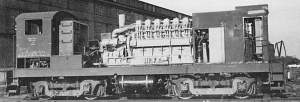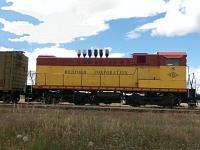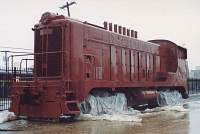
|
On early VOs (left) the stack was flush with the top of the hood, on later VOs (right) the stack was taller |

|
close up |
This continued until 1944, when it was found that the single muffler and exhaust created backpressure, restricting the flow of the exhaust and retaining heat. The excess heat generated so close to the electrical system caused it to overheat and fail. This was addressed with a new exhaust manifold. This took the form of 2 separate manifolds each with its own stack, creating the dual stack variety. On the VO660, there were 3 cylinders per stack. On the VO1000, there were 4 cylinders per stack.

|
Dual stack VO660 |

|
Dual stack VO1000 |
While this removed the problem of overheating the electrical system, it still restricted the flow of the exhaust. Thus another change was made. On the VO660, this was done by simply adding another stack to each manifold to relieve the pressure. On the VO1000, 4 separate manifold sections were installed serving 2 cylinders each. This led to the 4 stack variety. The VO660 had 2 groups of 2 stacks spaced close together, but the VO 1000 had the four stacks spaced evenly apart.

|
Four stack VO660 |

|
Four stack VO1000 |
Later, on the DS and S series switchers, Baldwin adopted the 3 stack setup as standard for the smaller normally aspirated type, and a single stack for the bigger turbocharged units.

|
Three stack normally aspirated DS4-4-660 |

|
Single stack turbocharged S12 |
As a side note, 4 stacks was not the limit on the varieties. Some railroads gave their units a separate stack for each cylinder, creating 6 and 8 stack models with a solid row of pipes above the engine. Baldwin called this practice "Hotrodding", in reference to the way people tricked out muscle cars.
Six stack S8 photo by: John Powell June 2011 |
Eight stack VO1000 photo by: Richard Adams Superior, WI - July 27, 1979 |
Eight stack VO1000 photo by: Robert A. Willis Dallas, TX - 2005 |
Seven stacks ?
There is one other oddball in the mix: Magma Arizona Railroad #9. This S-8 switcher was built for McCloud River RR as their #31. It was made as an S-8 that could be upgraded to an S-12 with the addition of a turbocharger. Thus, it had a single exhaust stack above the generator. When it was transferred to Magma, somehow the hood roof of another S-8 with 6 stacks was swapped out with its original hood. These stacks are dummies, as the manifold is still routed to the single large stack. Thus, it is the only Baldwin switcher, or any other locomotive I know of for that matter, to have 7 smoke stacks!




